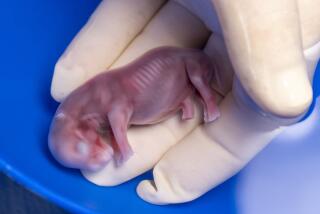Italian Team Is First to Clone a Horse
- Share via
Scientists have announced the birth of the first horse clone -- a female foal genetically identical to the mare who bore her.
Announced three months after the birth of a cloned mule, the achievement opens the door for applications such as the cloning of valuable geldings that couldn’t otherwise pass on their genes, and the preservation of endangered species of horses.
However, it is unlikely the technology will ever be widely employed in horse racing because of strict rules governing the registration of horse breeds. Even artificial insemination is a no-no for the Jockey Club, which regulates American thoroughbred racing.
The foal, named Prometea after the Greek god Prometheus, was born May 28 at the Laboratory of Reproductive Technologies in Cremona, Italy, but her birth wasn’t announced until today in the journal Nature.
To create Prometea, the scientists obtained horse ovaries from slaughterhouses and ripened horse eggs in the laboratory. Genetic material was removed from the eggs and replaced with DNA of skin cells taken from either a male or a female horse.
From more than 800 such attempts, 22 embryos successfully developed to the seven-day stage of embryo growth; 17 were placed in mares, and four pregnancies resulted. Prometea was the only foal to be carried to term.
As it happened, the surrogate mother who bore her was the source of the DNA used in the cloning, said Cesare Galli, director of the Laboratory of Reproductive Technologies and leader of the effort. That means mother and foal are genetically identical except for a very small amount of DNA from the egg donor.
“This had never been done before -- I think we were quite surprised by the outcome,” Galli said. Scientists had believed that a fetus must be genetically distinct from its mother for the pregnancy to take.
“I think this assumption should be revised with our experiment,” Galli said.
Since the 1996 birth of Dolly the sheep clone, scientists have successfully cloned a range of animals including cows, pigs, mice and goats. Horse cloning was trickier because less was known about culturing eggs and embryos in horses.
The news from Italy “is wonderful -- it’s a big advance over the mule clone born earlier this year,” said Katrin Hinrichs, a professor at Texas A&M; University in College Station. Hinrichs’ team is expecting the birth of another horse clone in November.
A few weeks before Prometea’s birth, a team of scientists at the University of Idaho announced that they had cloned the first equine: a mule named Idaho Gem, the genetic brother of a famous racing mule named Taz. The effort was backed by Taz’s businessman owner.
The strategy used in the mule cloning would not be commercially practical, Hinrichs said. The mule team used more than 300 naturally matured eggs taken from live mares -- collected individually, one per mare per reproductive cycle. Its members created a fetus to supply the genetic material used in cloning and surgically implanted the new clones into the oviducts of the surrogate mothers.
In contrast, the Italian and Texas teams used immature eggs obtained from slaughterhouses. They cultured skin cells for a DNA source and inserted 7-day-old embryos into mares through the cervix, which is a nonsurgical procedure.
Cloning is expressly banned by some horse breed organizations such as the Jockey Club and the American Quarter Horse Assn., and there are thus many races in which a clone or its offspring would not be permitted to participate.
“If someone had Seabiscuit’s DNA they had better sell it on EBay because they’re not going to register any Seabiscuit animals that are cloned,” said Bob Curran Jr., vice president of corporate communications for the Jockey Club.
However, there are other events, such as dressage and show-jumping, where rules are not as strict because competing horses do not have to be registered, Hinrichs said. Cloning could also be useful in increasing the genetic pool of endangered horse species such as the wild Przewalski’s horse and could aid in the investigation of certain horse diseases, to determine whether the causes are genetic or environmental, she said.
More to Read
Sign up for Essential California
The most important California stories and recommendations in your inbox every morning.
You may occasionally receive promotional content from the Los Angeles Times.










